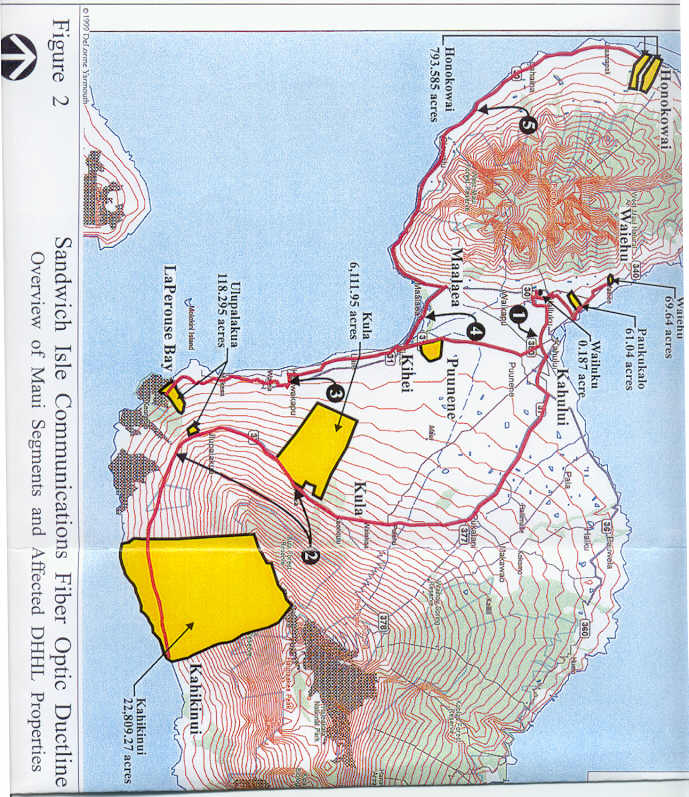The Maui News
April 27, 2001
By VALERIE MONSON
Staff Writer
WAILUKU — A proposed $500 million fiber optics cable system that would provide high-tech hookups to every parcel of Hawaiian Homes land on six islands was met with criticism – and suspicion – by the Maui/Lanai Islands Burial Council Thursday.
"These lines are telling a different story," said Leslie Kuloloio, a former member of the council who was testifying on his own behalf, as he pointed to a map covered with red lines over land and under the ocean that would connect the project.
"These lines aren't geared for Hawaiian Homes – they're geared for a big picture 50 years from now," he said.
The system has been proposed by Sandwich Isle Communications, an Oahu-based public utility company certified as a rural telephone company by the state Public Utilities Commission and Federal Communications Commission. The company, formed in 1995, is owned and operated by Native Hawaiians.
Although Sandwich Isle spokesman Gil Tam insisted the main purpose of the project was to offer state-of-the-art communications to Hawaiian homesteaders, the Native Hawaiians of the Burial Council feared their lands were being used to create a huge network for the public at large as well as commercial ventures and, possibly, the military.
"What about the Department of Defense? The Department of Energy?" wondered Kuloloio. "Are they another part of the big picture that we don't see? How many Hawaiians have computers and Microsoft? We're at the bottom. What we need is water. I'd like to see all these lines be waterlines."
Chairman Charles Kauluwehi Maxwell Sr. and Vice Chairwoman Dana Naone Hall were especially surprised that the cable would run all the way to LaPerouse Bay just to connect a small piece of Hawaiian Homes land that no one on the council even knew was part of the trust.
"I'm shocked, I've never even heard of that being homelands," said Maxwell. "There's nothing there but lava. There's no water there. People won't be able to live there for at least 50 or 100 years."
Maxwell pointed out that costs for the project will soar even more because of all the archaeological work that will be needed to address the expected concentration of ancient graves and historic sites through the South Maui corridor to connect LaPerouse. He said it would also needlessly disturb the bones of the ancestors.
"How is this (project) practical?" he asked. "I can't see digging through intense, intense (layers) of archaeological sites and burials for (a community) that might not even occur."
Hall called the draft environmental assessment prepared for the project "premature," because the system would be built in phases and things would inevitably change over the years.
She also called the archaeological assessment prepared by Cultural Surveys Hawaii Inc. of Oahu "extremely inadequate" in describing the minimal impacts on burials that would result from widespread trenching.
Maxwell said the Burial Council has "had a lot of problems" with work done by Cultural Surveys Hawaii in the past and suggested that Sandwich Isle hire a Maui firm.
Kuloloio was also concerned that there had never been a public hearing about the system for Hawaiian homesteaders on Maui.
Tam said the idea for the project came from Hoaliku Drake, a past chairwoman of the Hawaiian Homes Commission. He said $400 million of the needed money would come from a loan from Rural Utility Services in the U.S. Department of Agriculture. The other $100 million would come from private sources.
The public would end up helping Sandwich Isle pay back the federal loan through charges on monthly telephone bills. Tam said when AT&T broke up several years ago, a fund was created by Congress to enable rural areas to keep up with cities in terms of technology. At that time, the charge was $1 per customer each month. Current charges were not available.
Tam said those fees "help companies like ours to pay back the loan."
No one on Hawaiian Homes land will be charged for any infrastructure. Individuals will only be expected to pay for their service.
The installation for Maui County would come to $30 million, with most of that being spent for Maui island.
Hall asked how Sandwich Isle would recoup its costs or ever make a profit considering that, in the near future, there probably will be barely 500 Native Hawaiian families on homestead lots across the island.
Tam finally acknowledged that the general public will be the major subscribers of the project. After the meeting, he admitted that the users might include the military.
"Anybody could" end up paying to tap into the network, he said.
Sandwich Isle hopes to obtain state or county permits to construct as many of the trenches as possible in public rights of way.
The Burial Council voted unanimously to require the developer to revise the environmental assessment, particularly the archaeological assessment. Members also asked to be included as a consulting party in further discussions.
Tam assured the panel that the company would not pursue a "finding of no significant impact" for the project and would remain in close communication with the Burial Council.
"We really want to do the right thing," he said.

Ho`iho`i Mai
Return